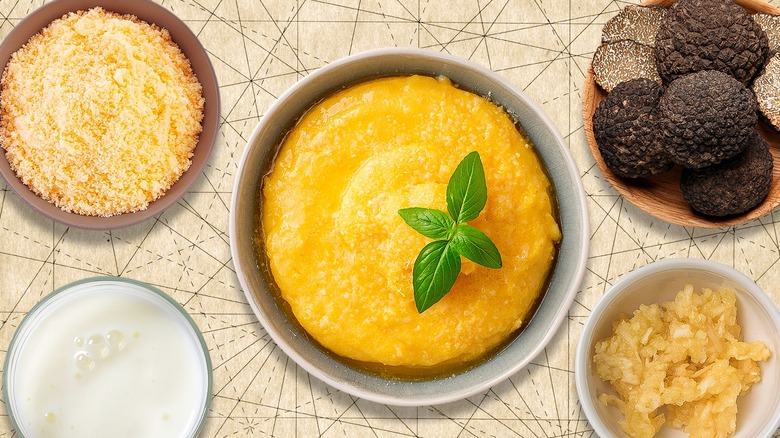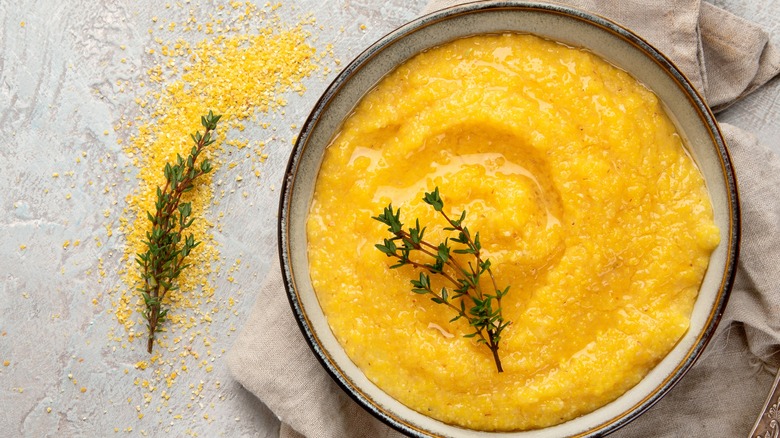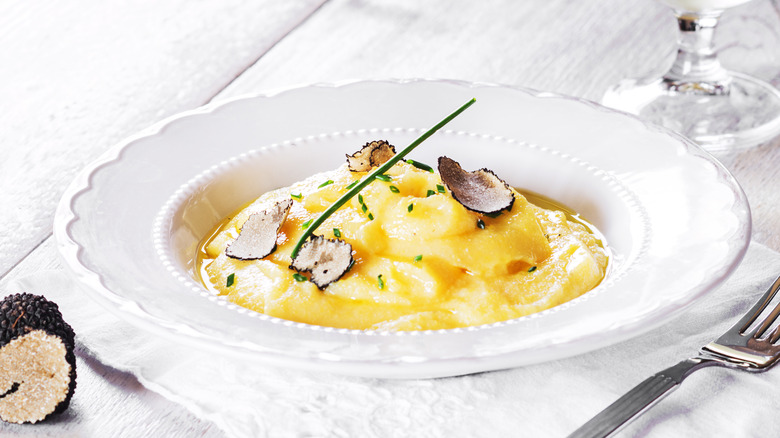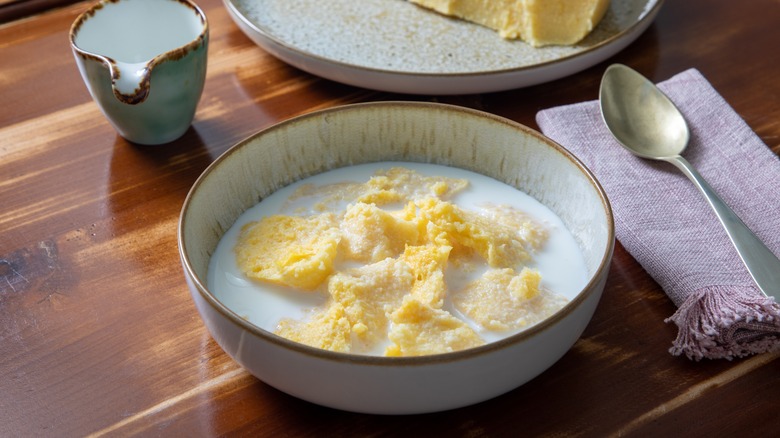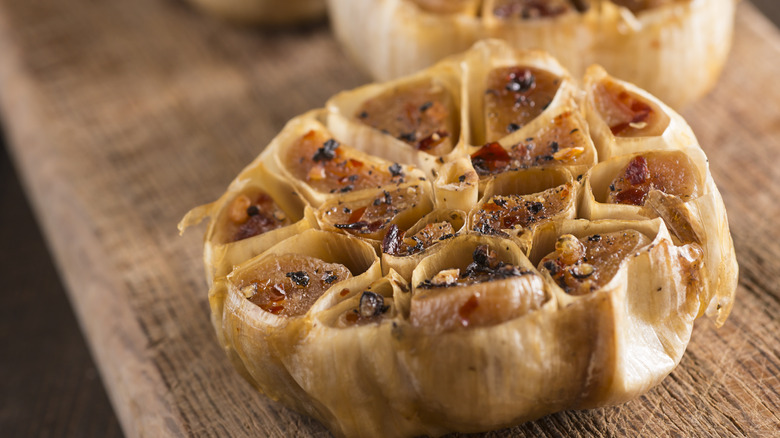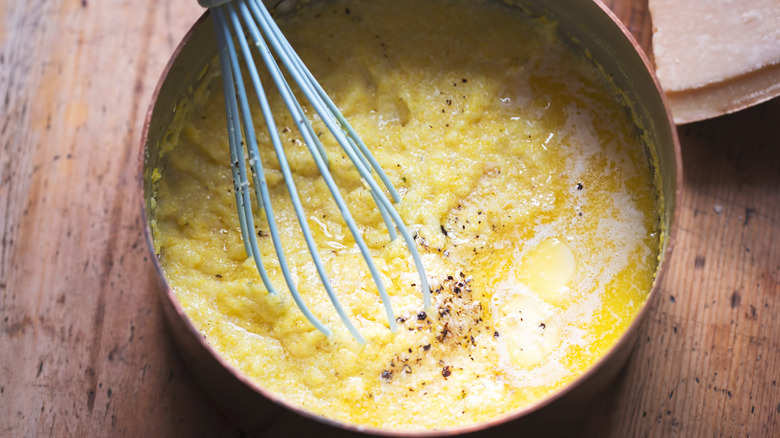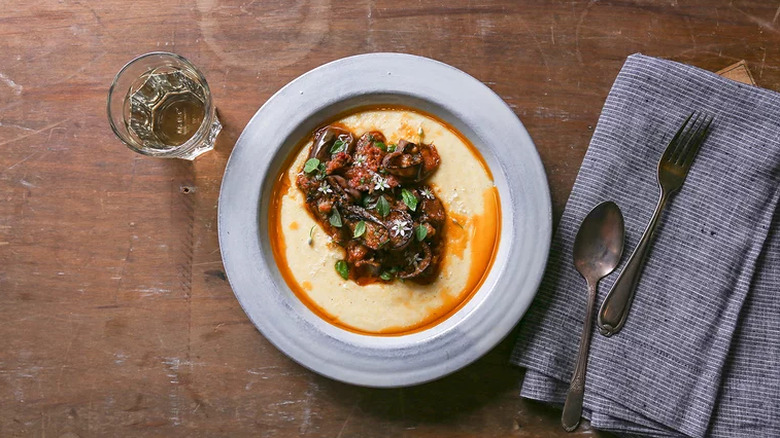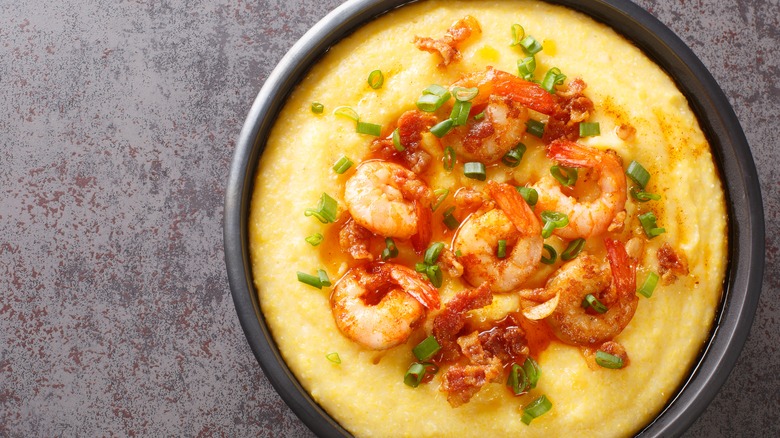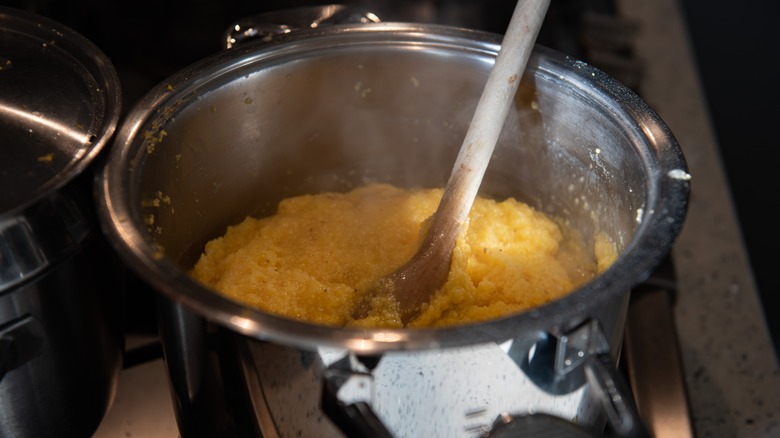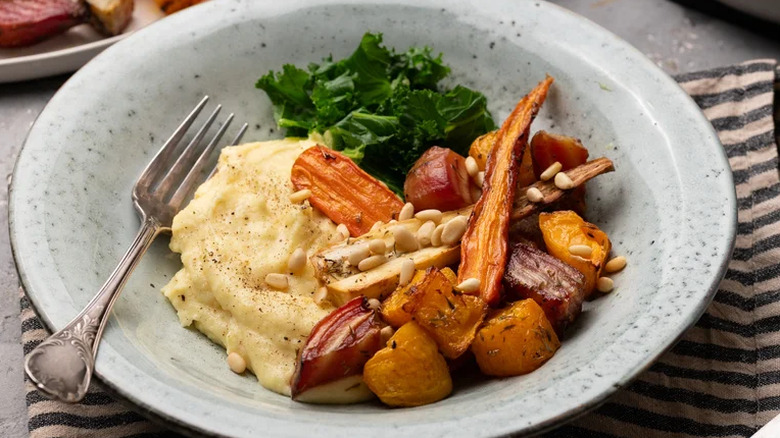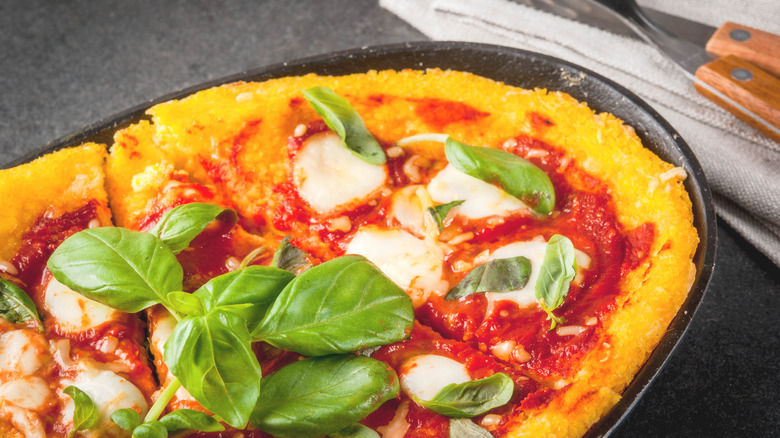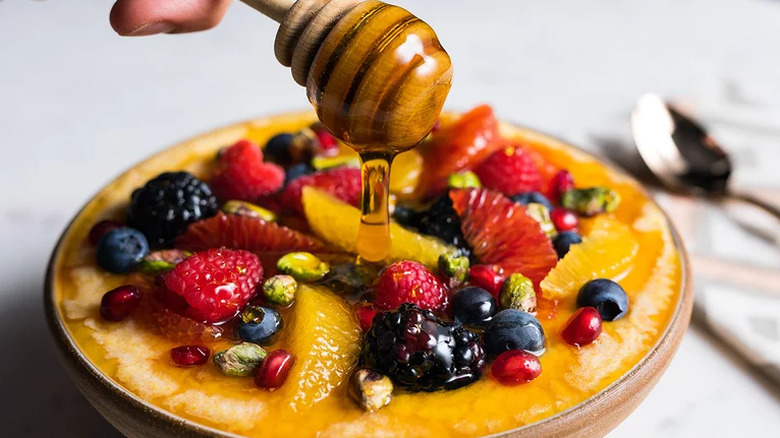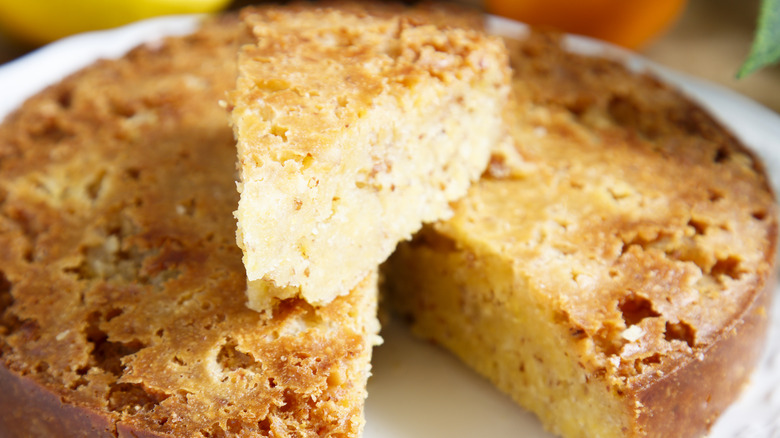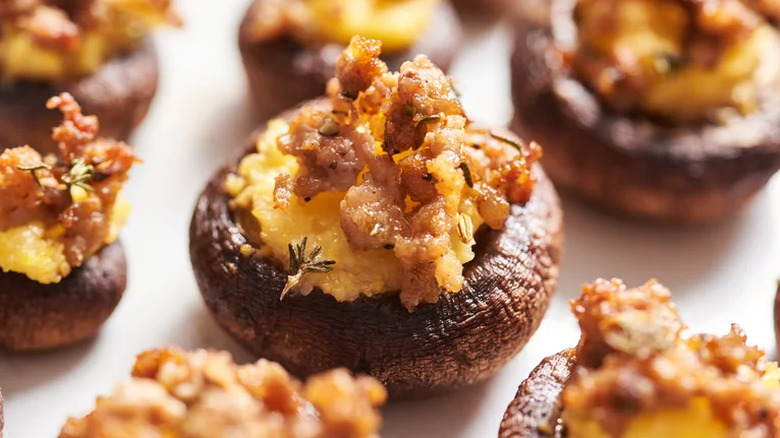13 Ways To Upgrade Your Polenta
Many countries have a type of starchy porridge that is enjoyed with meals or for breakfast, and in Italy, that's polenta. This dish of northern Italy dates back to ancient Rome, and was made with grains like spelt, rye, or buckwheat, and even legumes like fava beans. Nowadays, it's rarely cooked with those ingredients and almost always cooked with cornmeal. While most commonly it's made from yellow corn, there are some towns or regions where white corn is used. It's served differently depending on the region or the cook. The texture can be soft and creamy like grits, or a bit drier — similar to a dough-like consistency — for a polenta that you can slice up like bread.
A staple in many Italian restaurants, polenta is the ultimate comfort food. Dried and ground corn is cooked until it's soft and velvety. This is the type of dish that people love to eat when dining out because it's not quite as easy to make as it looks. In Italy, it's traditionally served as an accompaniment and prepared quite simply, with some salt, butter, olive oil, or cheese. However, because it has quite a neutral taste, it's a dish that lends itself to many variations, flavor additions, and exciting ways to jazz it up and make it even better. Whether it's about how you cook it, how you eat it, or what you serve it with, the versatility of polenta is endless. Here are some of the best ways to upgrade your polenta.
1. Blend in mascarpone
Many people have that one secret to making a perfect polenta, and this can range from cooking tips to hidden additions. While it's a relatively simple dish to cook, there are some ways it can go wrong. It can burn if not stirred often enough, it sometimes splashes out and can singe you if you're not careful, it can get dry and be undercooked if there's not enough water, etcetera. Then there are many conflicting messages. Some advise to start with boiling water, while some say it should be cold. Some say cover, others say don't. Whichever way you go, the truth is that you just need a little patience, to stir it occasionally, and usually to follow the instructions on the packet, because the ratio of water can differ according to the type of polenta or cornmeal.
Near the end of cooking, many people add butter to give polenta flavor, richness, and shine. While butter is great, there's another simple addition that will instantly enrich your polenta. Mascarpone cheese is an easy way to give your polenta an indulgent feel, without the need for butter or much else at all. Add a couple of teaspoons of mascarpone to your polenta when it's almost done cooking, and you'll see it shine while giving it a rich and creamy flavor.
2. Top polenta with truffles
Polenta is often served with mushroom dishes in Italy, and they are a match made in heaven. Polenta works with mushrooms for the same reason it goes with meat stews. Silky polenta goes great with earthy, smoky mushrooms, allowing their flavor to shine while balancing them out with a mild sweetness. It makes for a great meal for vegetarians and meat eaters alike. We especially love this mascarpone polenta with wild mushrooms recipe.
There is another type of fungi that will take your polenta to the next level. Truffles have a distinct, luxurious flavor that can elevate any dish. They require an accompaniment that will allow their flavor to shine through, without competition, and polenta does just that. Topping your polenta with truffles will turn humble porridge into something fancy and special, making it great for a dinner party or even an indulgent meal for one. If you can't find truffles in season, you can always top your polenta with truffle oil to give it a bit of that dreamy truffle taste.
3. Go sweet with milk and sugar
Polenta is just ground corn, making it neither sweet nor savory. How you cook and season it will determine the flavor. That's what makes polenta so versatile, and eating it sweet is just as simple as eating it savory. Given that it's a porridge-like meal, it makes for a great breakfast option, which isn't unusual to do and it's even eaten this way in Italy. A classic pair of easy ingredient additions for rich breakfast polenta are simply milk (dairy or plant-based) and sugar.
To make breakfast polenta, you can cook polenta with milk and sugar, or simply reheat your leftover polenta with milk and sugar. Keep in mind that you can only do this if you've originally cooked your polenta with water or milk, rather than a savory ingredient like chicken stock. However, as many Italians cook polenta with water, eating it sweet for breakfast the next day makes for a great way to use up leftover polenta, especially if it's become dried out. Rehydrating polenta with warm milk makes it soft again, and a comforting and nutritious way to start your day.
4. Mash some roasted garlic into your polenta
Garlic lovers will swear that garlic can go on anything. It certainly adds a tasty kick to many dishes, but with polenta, it can sometimes be a little bit too sharp. In theory, the two should go together, but in reality, it doesn't work quite as well as we imagine. However, garlic is also a versatile ingredient that can be cooked in different ways. When you roast garlic whole, the process transforms it completely, making it soft and fluffy with a milder and slightly sweeter garlic taste.
Using roasted garlic is one of the best ways to add garlic to polenta, because it doesn't have the same raw-garlic sharpness that can overpower the subtle taste of cornmeal. Instead, the delicateness complements it. To add roasted garlic to your polenta, mash up the soft flesh first, then blend it through your cooked polenta into one uniform mixture. It will upgrade your polenta with a complex but pleasing umami flavor. An added benefit is that it won't give you garlic breath.
5. Sprinkle Parmesan to make a cheesy polenta
As is often the case, adding cheese can only make polenta better. Cheesy polenta isn't a new thing, and Italians often add Parmesan to polenta. This not only adds gooey richness as it melts into the polenta, but also seasons the polenta since Parmesan is a salty cheese. In truth, many types of cheese would work nicely with polenta, and this is one of the easiest ways to upgrade it. You can stick with a hard cheese like Parmesan (or even pecorino Romano) to get a consistently good result, or you can be bold and add blue cheese to add a stronger and funkier flavor.
This creamy three-cheese polenta recipe combines Parmesan with goat cheese and brie, hitting all the cheesy marks we want. The saltiness from the Parmesan, the umami and creaminess from the goat cheese, and the gooeyness from melted brie will turn your simple polenta into an extravagant dish that will impress on its own or as a decadent accompaniment.
6. Get fancy with ragout
Polenta and stew were made for each other. Mushy polenta makes for the perfect carrier for a slow-cooked stew like ragout. The sauce in the ragout mixes in beautifully with the pillowy corn dish, creating layers of flavor and comforting softness. This hearty combination is especially welcomed in colder months, when one needs a richer and more satisfying meal.
A misconception about ragout (not to be confused with ragu, the Italian type of meaty pasta sauces like Bolognese) is that it has to have meat in it. However, ragout is the French style of making a slow-cooked stew and can be made with meat, fish, or vegetables. All types of ragout pair perfectly with polenta.
For a vegetable ragout that rivals any meat version, eggplant ragout with creamy polenta is a winner. The eggplant is seared to get a smoky caramelization, then thrown into a stew made with shallots, tomatoes, herbs, and red wine. If you don't like eggplant or don't have any, the same recipe works just as well with mushrooms and other vegetables.
7. Flavor polenta with broth
One of the most effective ways to impart deeper flavor to your polenta without too many other frills is to cook it with broth. Instead of using only water, use a well-made broth of chicken or vegetable stock and cook your polenta with it. That way, the cornmeal absorbs flavor directly, rather than relying on toppings at the end of cooking to add taste. A pot of stock or broth is one of the best things to have in your cooking repertoire, and if you make a large amount, you can freeze it in portions to boil into all sorts of recipes like soups, stews, and sauces. You can also use it to cook rice, potatoes, grits, and more, just like how you would with polenta.
If you've ever wondered why polenta at a gourmet restaurant tastes so dreamy, the chef has likely cooked it with broth. Dashi, a savory type of Japanese broth, is the secret ingredient David Chang uses for flavorful shrimp and polenta. Dashi is commonly made from kombu (dried sea kelp) and katsuobushi (fermented and dried fish shavings), making for an umami-packed and smoky broth. How deep the broth's flavor is will ultimately determine how delicious your polenta will taste.
8. Turn off the stove
When it comes to cooking polenta from scratch instead of using the instant stuff, we know that it can be a bit of a tricky and laborious process. You need to make sure to stir out the lumps while stirring enough so that the bottom doesn't burn. However, it's not easy to stand and watch over your pot of bubbling polenta for 30 or 40 minutes, not to mention the elbow grease needed to keep stirring. Well, there's a shortcut that can help you leave it to cook on its own, without the hassle of stirring every couple of minutes.
The absolute best way to guarantee creamy polenta is to first boil your broth before turning off the heat, before gradually whisking your polenta into the hot broth. Then simply leave it to stand for 45 minutes. The polenta will slowly absorb the broth, cooking it in the process, with no stirring required.
9. Celebrate root vegetables with your next polenta
Polenta doesn't always have to be the base for a meat-dense meal. It goes just as well with veggies of all forms. From mushroom stew to eggplant ragout, there are numerous ways to enjoy polenta with vegetables. One of the easiest ways to do so is with a pan of roasted veggies. Roughly chopping up some vegetables and then roasting them in a pan with olive oil and seasoning is one of the easiest ways to enjoy polenta. This is because you can focus on cooking your polenta — which is already a bit of a labor of love — while your vegetables are roasting in the oven.
Roasted vegetables become caramelized and slightly sweet, adding different textures and taste profiles to a creamy polenta. We love choosing a selection of root veggies like carrots, beets, and parsnips to make this colorful roasted root vegetable polenta recipe. Paired with a cheesy polenta, this makes for a hearty and nutritious weeknight meal. The added pine nuts match the nutty flavor in the polenta, and add an extra layer of decadence.
10. Innovate with polenta pizza bases
One of the best things about polenta is how versatile it is to use as leftovers. It gets a bit firmer the longer it stands and dries out a little as it cools, but that's perfect for repurposing it. You can rehydrate it and soften it again with warm milk, butter, or broth, or you can take advantage of its firmness and grill up some polenta squares. Another idea is to use leftover polenta for quick and easy gluten-free pizza crust. This technique requires that you allow polenta to set in the fridge for at least an hour or overnight, making it perfect for leftovers.
Coat a pizza pan with some oil, and then press your polenta into it, rolling it out into an even pizza base before transferring it to the fridge to set. Then when it's time to make your pizza, pre-bake the base for half an hour before you add cheese and other toppings of choice. Pre-baking allows your polenta base to be crisp and avoid a soggy bottom. Then place it back into the oven until your cheese melts. Polenta pizza isn't firm enough for you to pick up a slice with your hands, but using a knife and fork will do the trick.
11. Make overnight breakfast polenta
You've already heard that you can eat polenta for breakfast, but there's another (some might argue better) way to do so than adding milk to dried, leftover polenta. Move over overnight oats, because overnight polenta is a revelation. Soaking your polenta drastically cuts down the cooking time, meaning it's actually possible to cook it in the morning. However, it also takes the taste of the polenta to the next level. The overnight soak allows the polenta to bloom and really bring out its flavor.
Make overnight polenta porridge by simply mixing a bowl of dried polenta in milk with a pinch of salt, and leaving it covered in the fridge overnight. In the morning, you'll cook it with a double-boiler technique on medium heat until it's thickened. Then, add all of your favorite breakfast toppings to a bowl of luscious, warm polenta. Drizzle on some honey or syrup, and add berries, citrus segments, or even some toasted nuts. You'll be amazed at how delicious breakfast polenta can be.
12. Transform polenta into cake
Polenta is not only something to be eaten as a porridge-like dish, but you can also use it in baking. Much like cornbread, corn muffins, or corn cake, polenta works beautifully in baked goods because of its subtle sweetness. Using polenta instead of flour can result in a grainy cake, but that's part of its charm. Plus, it's gluten-free, making it an easy entryway into gluten-free baking for those who aren't experienced with it.
There are plenty of possibilities for flavor pairings with polenta cake. Some obvious choices are citrus cakes like lemon or orange, as their zest adds a beautiful fragrance to polenta. A less obvious choice is olive oil, which creates a complex polenta cake. Using olive oil also means you don't have to use butter, meaning no need for creaming butter, so it's much easier to mix. It's also milk-free, making it suitable for people who don't eat dairy. We love this olive oil polenta cake recipe.
13. Use it as stuffing
Stuffed foods aren't always the most glamorous looking, but they certainly make up for that in deliciousness. You can make stuffing using all kinds of things, and depending on the recipe, it can be cooked or par-cooked. Another win for polenta's versatility is that it can also be used in stuffing mixtures. However, it's best to pre-cook polenta before stuffing anything with it. Since it takes a while to cook, you don't want to have crunchy, undercooked polenta while the rest of your meal ingredients are ready to go.
There are many things you can stuff polenta with, but this polenta and sausage-stuffed mushrooms recipe proves that sometimes, stuffing can be glamorous. Hollow out your mushroom tops the way you usually would, and add your cooked polenta into the little wells, followed by the sausage. Bake and serve warm. The key to great polenta stuffing is to make sure it's tasty on its own. So taste, season, and add butter, cheese, or other flavor enhancers before you stuff.
